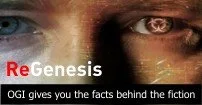 Fringe
Fringe, JJ Abrams new series, is like an updated
X-Files where every week a gory and mysterious event is investigated. Unlike the
X-Files, however, there aren't alien bounty hunters or human-alien hybrids. Instead, it's science run amok ("The Pattern"), stemming from the decades old research of
Dr. Walter Bishop and his colleagues. Bishop isn't the bad guy, though, since he's spent the past 17 years in a mental institution. His is old "lab partner" William Bell, is another story. He's the founder and CEO of
Massive Dynamic, a giant corporation which is seemingly involved all aspects of cutting edge technology, from genetic engineering to artifical intelligence to rapid transportation. It also has suspiciously advanced R&D labs. Could Massive Dynamic be behind "The Pattern"?
To investigate these events, an unlikely team has been brought together: FBI Agent
Olivia Dunham; brilliant Dr. Bishop, on furlough from the mental hospital; his estranged son
Peter Bishop, a "jack of all trades" who is naturally brilliant at math and chemistry (and,
it was hinted this week, of unnatural origin); and Homeland Security Agent
Phillip Broyles, who seems to know more about The Pattern than he's telling.
This week's episode, "
The Same Old Story", had a horrific beginning: a young man and woman are in a hotel room, when suddenly the woman starts to writhe in agony and we see something moving and growing in her abdomen. She dies just before giving birth in the hospital to a rapidly growing infant that dies of old age a mere four hours later. Dr. Bishop recognizes that this may have something to do with some of his Vietnam War era research that aimed to rapidly grow soldiers from
eggs fertilized in vitro. While they were successful in using pituitary extracts to stimulate rapid growth, so that the lab-reared soldiers reached the physical age of 21 in a mere 3 years, the scientists on the project were unsuccessful in stopping the rapid aging at that point. Soldiers aren't too useful if they are only at their physical prime for only few months, so the project was abandoned. One of my pet peeves about the "clone an army" trope is that it's inefficient if you have to wait decades for replacements to develop, so it's fun to see that problem turned on its head. So is there anything to the science? Could a pituitary extract really rapidly advance aging? Almost certainly not.

The pituitary gland
secretes a number of different hormones including growth hormone and
thyroid-stimulating hormone.
Growth hormone increases height in children and adolescents, stimulates the growth of internal organs, along with a number of other effects. Children with overactive pituitary glands that produce excess growth hormone
can end up 7 or 8 feet tall, but they don't age any faster than usual. Thyroid-stimulating hormone does what the name suggests: it stimulates the release of
thyroid hormones from the thyroid. Thyroid hormone regulates metabolism and works with growth hormone to promote growth in children (among other functions). Excess thyroid hormone production -
hyperthyroidism - have an increased metabolism. Again, no effect on aging. But what if embryos, rather than children, were exposed to high levels of hormone?
Overexpression of growth hormone in frog embryos causes the tadpoles to grow twice their normal size before metamorphosis, but they don't develop any faster than their untreated siblings. And while thyroid hormone is
necessary for normal development of the brain and other organs, again there is no indication it affects the rate of development.
So is the science in this week's episode completely made up? At the beginning of the episode, Dr. Bishop mutters about cell cycle inhibitors.
"Disabling and reversing cell cycle inhibitors. Activating and turning CIP/KIP and INK4a/ARFs into catalysts."
It may sound like gibberish, but what he is talking about are proteins that normally cause cells to stop the cell division cycle by inhibiting the function of
cyclin-dependent kinases (CDKs). It seems that
Fringe's resident genius thinks that rapid aging is caused by excess cell division.
The Dapper Alchemist explains why they aren't equivalent:
Dr. Bishop previously mentions that one can induce conditions, such as progeria [rapid aging], through pituitary gland modulation. Although the pituitary gland is affected in progeria2, I’m not sure if it can be induced as such. Reduction of the CDK-inhibitor function of certain domains causes enhanced tissue growth, which manifests in animals with larger body size3 and leads to increased cell proliferation in the pituitary gland. It seems that JJ has muddled together enhanced tissue growth with rapid aging, the two don’t necessarily go hand-in-hand.
So stimulating division of cells can mean excess growth, but not rapid aging.
But the aging effects of the pituitary turn out to not be that important anyway. The bad guy on this week's show is a serial killer who removes the pituitary from his young female victims while they are still alive. That method that is apparently more satisfying than simply
purchasing pituitary extract from Sigma (or maybe he couldn't get a purchase order). Anyway, it turns out he is the last remaining "rapid growth" test subject who must have fresh pituitary to keep him from aging. Growth hormone does have some
anti-aging properties, so I suppose it's not too much of a leap to suggest that it stops aging all together.
My impression so far is that the science in
Fringe ranges from sort-of-implausible to completely impossible. It's no worse that
X-Files or
Star Trek, though, and I have enjoyed watching it. I like the truly mad Dr. Bishop, who chooses a single cow as his experimental organism, and he keeps her in his basement lab where she gets to watch
Spongebob with him. And evil corporations running secret experiments and possibly plotting to take over the world are plausible villains. I'll tune in again next week.
More about the science of
Fringe:
Tags:Fringe, biology






















